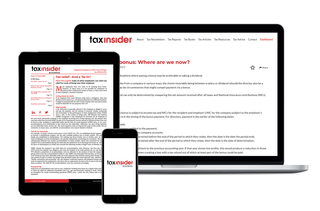 Ken Moody explores the scope of a sometimes overlooked provision in the private company loans to shareholders rules, which could give rise to an unexpected ‘loan’ to the Treasury.
Ken Moody explores the scope of a sometimes overlooked provision in the private company loans to shareholders rules, which could give rise to an unexpected ‘loan’ to the Treasury.
----------------------
This is a sample article from our business tax saving newsletter - Try Business Tax Insider today.
---------------------
HMRC does not like private companies lending money to their owner-managers, and there is a raft of provisions aimed at discouraging such debts – from benefits-in-kind rules to the ‘quasi-distribution’ provisions in CTA 2010, Pt 10, Ch 3, which kicks off with the notorious section 455.
If a loan remains outstanding for more than nine months following the company’s year end, CTA 2010, s 455 requires payment of notional corporation tax but at the dividend upper rate (currently 33.75%) rather than at the corporation tax rate. The tax is, however, repayable as and when the debt is repaid, or (at the expense of an income tax charge) is released or written off.
Closed loophole
Section 455 is extended by section 459 where, under arrangements made by a person (P):
(a) a ‘close’ company makes a loan which otherwise does not give rise to a section 455 charge; and
(b) another person makes a payment, transfers property to or releases a liability of a ‘relevant person’, such as a shareholder of the company or their associate.
Section 455 applies as if the loan had been made to the relevant person.
It would be an obvious loophole if, to avoid section 455, P could arrange for company A to make a loan to a third party (B) who then lends the money to P. Note, however, that section 455 refers only to a ‘payment’, not necessarily a loan, which is relevant to the situation next described. If B were another company in which P is a shareholder, it is conceivable that section 455 could apply to the loan from Company B and also, by virtue of section 459, to the intercompany loan from Company A.
Practical situations
A management buyout usually involves interposing a holding company which receives finance from the target company to buy out the departing shareholders. If the finance takes the form of an intercompany loan, the loan, together with the payments made to the outgoing shareholders, falls within the wording of section 459. The deal should therefore be financed by intercompany dividends as far as possible. HMRC insists that there is no motive test involved and does apply section 459 in practice in this situation (see HMRC’s Company Taxation Manual at CTM61550).
An even more ‘innocent’ scenario which I recently encountered concerned two connected companies, where company A had lent money to company B, and P (who was the major shareholder in both companies) had a substantial credit balance on his director’s loan account (DLA) with company B. P had already made some withdrawals from his DLA and wished to make further withdrawals.
It had also been suggested that company A, which was cash-rich, could make a further advance to company B, which was cash-poor, to enable B to repay P’s DLA. I was comfortable in advising that section 459 did not apply to the earlier withdrawals as these were not part of ‘arrangements’ made by P for A to lend money to B and for B to make a payment to P. But if A made a further loan to B to enable P to withdraw money from his DLA with B, that would fall squarely within the terms of section 459 – albeit that he would simply be withdrawing money lent personally to B.
Practical tip
If it is intended to repay part of a debt owed to a shareholder in two connected companies at a time when there is an intercompany debt between them, as described here, care is needed to identify whether the circumstances are within the wording of section 459, given HMRC’s strict interpretation. In the above scenario, another solution might be to assign the DLA to company A, subject to obtaining specialist advice.



